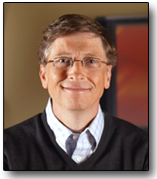Bill Gates Milestones: Part 1
Feature - You could hardly miss the news this week that Bill Gates is retiring from the company he co-founded.

Feature - You could hardly miss the news this week that Bill Gates is retiring from the company he co-founded. You may love him, you may hate him or you may not care. But it is an undeniable fact Gates has impacted the lives of most of us, pioneering a time in which the PC has changed from being an expensive and mostly useless machine for home users into a commodity. Reason enough to look back in history and highlight the most important milestones of Gates’ career. This first part covers Gates pre-1980 time.
Bill Gates is not an ordinary guy. You don’t become the richest person on the planet (currently he is in #3) by pure coincidence. The stars were aligned since his birth and early childhood. A wealthy environment provided top education, which may have contributed to his sharpened thinking and quick mind reflexes.
But he wasn’t destined for a career his parents had in mind. His love for the software became evident in his early teenage days and is still apparent today, even now that he is 52. Few believe that his retirement is just a sign that has lost passion for software and technology, but it is simply interpreted as a move to pursue opportunities for his charity and to make room for next-generation of young and upcoming leaders that will bring fresh thoughts into the company.
However, the history of Microsoft and Bill Gates are two inseparable stories, one closely tied to the other. Unfortunately, we have never had the opportunity to interview Gates, but, over the years, we talked to many visionaries in the industry who told us countless stories about their experiences with Gates. Probably most interestingly, our managing editor Wolfgang Gruener, interviewed Intel’s Pat Gelsinger in 2005 who commented on Intel co-founder Andy Grove and Bill Gates in this way:
What about comparing Grove to Gates? "Both men are brilliant," he said. "But everyone in the industry feels that with Bill there is always a Microsoft angle in everything that is going on - you just have to figure out where it is. With Andy, there is this intellectual integrity to look out for the best interests for the industry as well. We drove USB, PCI, and other things that had huge positive effects on the industry. There is almost this irritation about Gates’ success despite the industry, while Andy’s success is with the industry."
"Both are very aggressive individuals, very bright and strategically very challenging."If you have a conversation with either one of them, you show up with your game face on. You have to be on top of your facts and data, because you realize that intellectually, you start any conversation with a serious deficit."
As Gates is preparing his departure from an industry he shaped over the past three decades, we decided to take a look at key milestones in Bill Gates’ life, starting from his early days and up today. This first installment covers the 1950s to 1980s.
A not-so-ordinary family
Sign up to get the BEST of Tom's Guide direct to your inbox.
Get instant access to breaking news, the hottest reviews, great deals and helpful tips.
The story of Bill Gates and his love for the software begins with the birth of William Henry Gates III, as he was fully named, on October 28, 1955. He was born in a wealthy family: His father was a respected lawyer, while his mother served on the board of directors for United Way and the First Interstate BancSystem (her father J.W. Maxwell was a national bank president). Gates also has two sisters. Kristianne and Libby. Although he was the fourth of his name in the family, he got the "III" suffix since his father had dropped his own "III" suffix. His parents decided to enroll him at age thirteen to an exclusive private school called Lakeside School, which exposed Gates to computers for the first time.
Love at first sight: Software
Gates gained computer experience by using computer time on a General Electric computer, which was paid for by Lakeside School’s Mothers Club from proceeds of the school’s rummage sale.
Gates reportedly wrote his first computer program in eighth grade, a tic-tac-toe implementation in BASIC that allowed users to play against the machine. He was fascinated by the way machine always executes the code perfectly, commenting "There was just something neat about the machine." He also wrote a program that schedules students in classes, modifying it in such a way that it placed him in classes with mostly female students. He later commented that "it was hard to tear myself away from a machine at which I could so unambiguously demonstrate success."
Hacking career at 13 and first $20,000 at 17
In the same year, Lakeside reached an agreement with Computer Center Corporation that allowed the school to continue providing its students with computer time. Gates and his friends began exploiting bugs in the operating system. When the company found out about it, it banned Gates, Paul Allen and the two other students from using the machine, but later offered the four students to debug company’s software in exchange for free computer time. Gates visited CCC’s offices to study FORTRAN, LISP and machine language source codes for programs that ran on the system. In 1971, Information Science hired the four banned students to write a payroll program in COBOL, providing them with computer time and royalties.
Gates made his first real money at the age of 17, while he was still attending Lakeside School. He formed a venture with Paul Allen called Traf-O-Data that made traffic counters based on the Intel 8008 processor. Gates made $20,000 in the first year of business, but it eventually died down when clients found out about his age. Gates graduated from Lakeside School in 1973, scoring 1590 out of 1600 on SATs.
BASIC, Altair and the Harvard "leave of absence"
At age 18, Bill Gates enrolled at Harvard in the fall of 1973. He was already familiar with various programming languages, minicomputers and mainframe systems and made it through the first two college years with ease. During his days at Harvard, he forged a strong friendship with Steve Ballmer, also a Harvard student who would become Microsoft’s CEO 35 years later.
Gates apparently was searching for bigger challenges than his studies and he found one particular challenge in the January 1975 issue of Popular Electronics magazine: Micro Instrumentation and Telemetry System’s (MITS) Altair 8800 microcomputer. Gates immediately called MITS president Ed Roberts to offer a demo of a BASIC implementation for the system. It is reported that he was just gauging MITs interest as he and Paul Allen did not have a single line of code available. When MITS accepted the proposal, Gates and Allen created their first Altair emulator that ran on a minicomputer and then used the emulator to develop BASIC interpreter for the Altair within two months. Gates demonstrated the BASIC interpreter to Roberts at MITS’s offices in Albuquerque to, which prompted Roberts to distribute and sell BASIC for his Altair 8800 system. Bill and Paul decided it was time to found a company.
"Micro-soft" and Microsoft: An early vision of the bigger picture
Paul Allen was hired into MITS to work on the project and Gates helped him out by taking a leave of absence from Harvard and moving to Albuquerque in November 1975. Steve Ballmer decided to continue with his business school studies and later joined Microsoft on June 11, 1980. Gates and Allen dubbed their newly formed partnership "Micro-soft".
Gates struck a business partnership with Paul Allen primarily to develop and sell the BASIC interpreter for the Altair 8800. However, Gates already had a bigger picture in mind: Having already played with Intel 8008 CPU three years ago, Gates kept a close eye on what was coming out of the semiconductor company. After the Intel 8080 processor had been released, Gates noticed that there was a $200 chip that could run BASIC - and power an affordable computer. He was betting on his believe that this chip would give birth to the completely new industry that would form around the concept of a consumer computer.
Microsoft & IBM: Take 1
When Apple put a personal computer on the map, IBM decided it should play a major part in this revolution, which resulted in the IBM PC. Gates figured this was a lifetime opportunity for his small company and made it his mission to become friends with the most powerful company in the industry. Microsoft delivered the BASIC interpreter for IBM PC, which in turn was ready to pay Microsoft a fixed and allegedly small fee for the service.
Microsoft and IBM: Take 2 - Deal of a century
At the same time, IBM needed an operating system that would power its PC. IBM initially thought about Digital Research, but a deal never materialized. Gates saw a window of opportunity. On August 12, 1981 Gates and Ballmer sat down to discuss the terms of an agreement with IBM executives. Gates proposed that Microsoft should be paid a small fee for every computer IBM sells. Fortunately for Gates, IBM believed that the real money was in hardware sales, not in the software. And even if Gates offered IBM an operating system, Microsoft did not have one at the time of negotiations. When IBM agreed to the deal, Microsoft bought a CP/M clone called 86-DOS for $50,000 from Seattle Computer Products and re-branded it to PC-DOS. The software was sold to IBM for a one-time fee of $80,000. However, Microsoft retained the copyright.
Cloning IBM: Milking PC clone-makers
IBM exclusivity lasted not very long. Columbia Data Products cloned its BIOS, which allowed Far East manufacturers to build computers with similar specs and 100% compatibility in regards to the software that was written for IBM’s PC. Microsoft simply re-branded PC-DOS as MS-DOS and pushed it aggressively to clone-makers. Microsoft was now taking a fee for the majority of PCs sold and that was enough to transition company from being a niche player into a major software company.
Early management days, packaging the future
One year after Gates and Allen had formed their Micro-soft partnership, they became independent of MITS: In late 1976, Gates dropped the hyphen and dubbed the company just "Microsoft." On November 26, 1976 Microsoft became a newly registered trademark with the US Patent and Trademark Office. Microsoft’s first international office was open for business in Japan, on November 1, 1978, entitled "ASCII Microsoft" (today it is called "Microsoft Japan"). On January 1, 1979 the company moved from Albuquerque to its new home in Bellevue in Washington. Gates restructured Microsoft as incorporated business, changing its name to "Microsoft, Inc.", on June 25, 1981. Bill Gates became president and Chairman of the Board, while Paul Allen became Executive Vice President. The new management pyramid would reflect key responsibilities for years to come.
Although Gates officially held the wheel to steer the company, he was really managing the company from its earliest inception. Gates successfully transitioned Micro-soft partnership into Microsoft and then Microsoft, Inc., restructuring the company when needed, expanding it and personally hiring people. But his most obvious contribution in those early days is a business model he devised as the basis for Microsoft growth and successful strategy.
Read tomorrow: 1980 - 1990
Christian Zibreg is an editor and writer whose work has appeared in Tom's Guide, TGDaily, Geek, BSN*, 9to5Mac, 9to5Google, and MakeUseOf. He also has experience in marketing, publishing, and public relations — but he specialises in writing content about Apple, Windows, and Google, and is currently an editor for iDownloadBlog.
